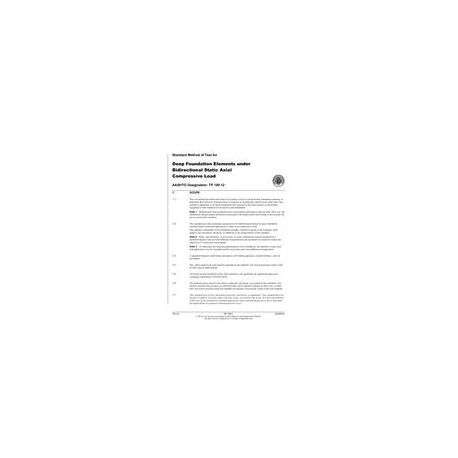Cart 0 Product Products (empty)
No products
To be determined Shipping
$0.00 Total
Product successfully added to your shopping cart
Quantity
Total
There are 0 items in your cart. There is 1 item in your cart.
Total products
Total shipping To be determined
Total
New Reduced price!  View larger
View larger
 View larger
View larger AASHTO TP 100-12 (2018)
M00001432
New product
AASHTO TP 100-12 (2018) Standard Method of Test for Deep Foundation Elements under Bidirectional Static Axial Compressive Load
standard by American Association of State and Highway Transportation Officials, 2012
In stock
More info
Full Description
This test method describes procedures for testing vertical or inclined deep foundation elements to determine their behavior characteristics in response to an internally applied axial static load. This method is applicable to all deep foundations that function in the same manner as bored piles regardless of their method of construction and installation.Note - Bidirectional load testing has been successfully performed on driven piles. However, the installation and procedural differences associated with bidirectional load testing of driven piles are not covered in this standard.
This standard provides minimum requirements for bidirectional testing for deep foundation elements under controlled application of static axial compressive load. The engineer responsible for the foundation design shall approve any deviations, deletions, or additions to the requirements of this standard.
Note - Plans, specifications, or provisions, or some combination thereof, prepared by a qualified engineer may provide additional requirements and procedures as needed to satisfy the objectives of a particular test program.
Note - To determine the long-term performance of the foundation, the duration of each load step application may be extended and the test results may need additional interpretation.
A qualified engineer shall design and approve all loading apparatus, loaded members, and test procedures.The method used to specify how data is collected, calculated, or recorded in this standard is not directly related to the accuracy to which the data can be applied in design or other uses, or both. How the results obtained using this standard are applied is beyond the scope of this test standard.

